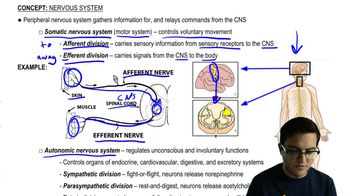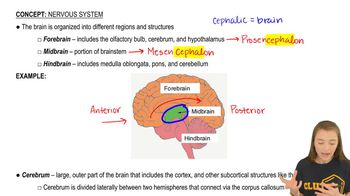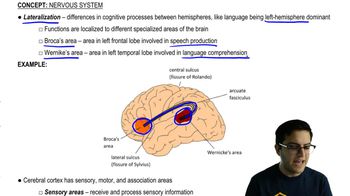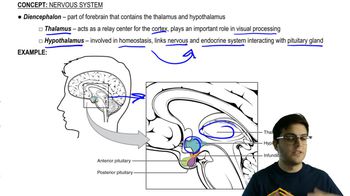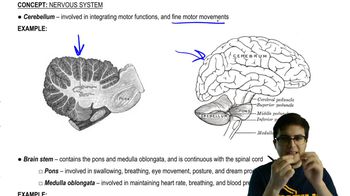Table of contents
- 1. Introduction to Biology2h 42m
- 2. Chemistry3h 40m
- 3. Water1h 26m
- 4. Biomolecules2h 23m
- 5. Cell Components2h 26m
- 6. The Membrane2h 31m
- 7. Energy and Metabolism2h 0m
- 8. Respiration2h 40m
- 9. Photosynthesis2h 49m
- 10. Cell Signaling59m
- 11. Cell Division2h 47m
- 12. Meiosis2h 0m
- 13. Mendelian Genetics4h 44m
- Introduction to Mendel's Experiments7m
- Genotype vs. Phenotype17m
- Punnett Squares13m
- Mendel's Experiments26m
- Mendel's Laws18m
- Monohybrid Crosses19m
- Test Crosses14m
- Dihybrid Crosses20m
- Punnett Square Probability26m
- Incomplete Dominance vs. Codominance20m
- Epistasis7m
- Non-Mendelian Genetics12m
- Pedigrees6m
- Autosomal Inheritance21m
- Sex-Linked Inheritance43m
- X-Inactivation9m
- 14. DNA Synthesis2h 27m
- 15. Gene Expression3h 20m
- 16. Regulation of Expression3h 31m
- Introduction to Regulation of Gene Expression13m
- Prokaryotic Gene Regulation via Operons27m
- The Lac Operon21m
- Glucose's Impact on Lac Operon25m
- The Trp Operon20m
- Review of the Lac Operon & Trp Operon11m
- Introduction to Eukaryotic Gene Regulation9m
- Eukaryotic Chromatin Modifications16m
- Eukaryotic Transcriptional Control22m
- Eukaryotic Post-Transcriptional Regulation28m
- Eukaryotic Post-Translational Regulation13m
- 17. Viruses37m
- 18. Biotechnology2h 58m
- 19. Genomics17m
- 20. Development1h 5m
- 21. Evolution3h 1m
- 22. Evolution of Populations3h 52m
- 23. Speciation1h 37m
- 24. History of Life on Earth2h 6m
- 25. Phylogeny2h 31m
- 26. Prokaryotes4h 59m
- 27. Protists1h 12m
- 28. Plants1h 22m
- 29. Fungi36m
- 30. Overview of Animals34m
- 31. Invertebrates1h 2m
- 32. Vertebrates50m
- 33. Plant Anatomy1h 3m
- 34. Vascular Plant Transport1h 2m
- 35. Soil37m
- 36. Plant Reproduction47m
- 37. Plant Sensation and Response1h 9m
- 38. Animal Form and Function1h 19m
- 39. Digestive System1h 10m
- 40. Circulatory System1h 57m
- 41. Immune System1h 12m
- 42. Osmoregulation and Excretion50m
- 43. Endocrine System1h 4m
- 44. Animal Reproduction1h 2m
- 45. Nervous System1h 55m
- 46. Sensory Systems46m
- 47. Muscle Systems23m
- 48. Ecology3h 11m
- Introduction to Ecology20m
- Biogeography14m
- Earth's Climate Patterns50m
- Introduction to Terrestrial Biomes10m
- Terrestrial Biomes: Near Equator13m
- Terrestrial Biomes: Temperate Regions10m
- Terrestrial Biomes: Northern Regions15m
- Introduction to Aquatic Biomes27m
- Freshwater Aquatic Biomes14m
- Marine Aquatic Biomes13m
- 49. Animal Behavior28m
- 50. Population Ecology3h 41m
- Introduction to Population Ecology28m
- Population Sampling Methods23m
- Life History12m
- Population Demography17m
- Factors Limiting Population Growth14m
- Introduction to Population Growth Models22m
- Linear Population Growth6m
- Exponential Population Growth29m
- Logistic Population Growth32m
- r/K Selection10m
- The Human Population22m
- 51. Community Ecology2h 46m
- Introduction to Community Ecology2m
- Introduction to Community Interactions9m
- Community Interactions: Competition (-/-)38m
- Community Interactions: Exploitation (+/-)23m
- Community Interactions: Mutualism (+/+) & Commensalism (+/0)9m
- Community Structure35m
- Community Dynamics26m
- Geographic Impact on Communities21m
- 52. Ecosystems2h 36m
- 53. Conservation Biology24m
45. Nervous System
Central and Peripheral Nervous System
Problem 7a`
Textbook Question
The reflex that pulls your hand away when you prick your finger on a sharp object relies on a neuronal circuit with two synapses in the spinal cord. Using a circle to represent a cross-section of the spinal cord, draw the circuit. Label the types of neurons, the direction of information flow in each, and the locations of synapses.
 Verified step by step guidance
Verified step by step guidance1
Begin by drawing a circle to represent the cross section of the spinal cord. This will serve as the central area where the neuronal circuit is located.
Identify and label the sensory neuron. This neuron detects the stimulus (e.g., the prick on the finger) and carries the information towards the spinal cord. Draw an arrow pointing towards the spinal cord to indicate the direction of information flow.
Inside the spinal cord, draw the first synapse where the sensory neuron connects to an interneuron. Label this synapse and indicate the direction of information flow from the sensory neuron to the interneuron.
Next, draw the interneuron within the spinal cord. This neuron processes the information and connects to a motor neuron. Draw an arrow from the interneuron to the motor neuron to show the direction of information flow.
Finally, draw the motor neuron, which carries the response signal away from the spinal cord to the muscles, causing the hand to pull away. Label the second synapse between the interneuron and the motor neuron, and indicate the direction of information flow towards the muscle.
 Verified video answer for a similar problem:
Verified video answer for a similar problem:This video solution was recommended by our tutors as helpful for the problem above
Video duration:
1mPlay a video:
Was this helpful?
Key Concepts
Here are the essential concepts you must grasp in order to answer the question correctly.
Reflex Arc
A reflex arc is a neural pathway that controls a reflex action. It involves a sensory neuron that detects a stimulus, an interneuron in the spinal cord that processes the information, and a motor neuron that triggers a response. This pathway allows for quick reactions without involving the brain, which is crucial for immediate responses to harmful stimuli.
Recommended video:
Guided course
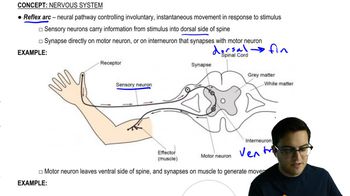
Reflex Arc
Types of Neurons
In the reflex arc, three types of neurons are involved: sensory neurons, interneurons, and motor neurons. Sensory neurons carry signals from the sensory receptors to the spinal cord. Interneurons, located within the spinal cord, process these signals and relay them to motor neurons, which then carry the response signal to the muscles, causing a reaction.
Recommended video:
Guided course

Neurons
Synapses
Synapses are junctions where neurons communicate with each other. In the reflex arc, there are two synapses: one between the sensory neuron and the interneuron, and another between the interneuron and the motor neuron. These synapses facilitate the transmission of electrical impulses, allowing the reflex action to occur swiftly and efficiently.
Recommended video:
Guided course

The Synapse

 6:53m
6:53mWatch next
Master Organization of the Nervous System with a bite sized video explanation from Jason
Start learningRelated Videos
Related Practice



